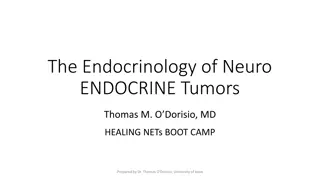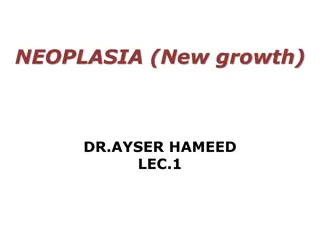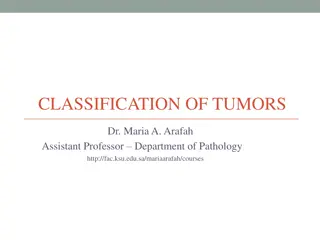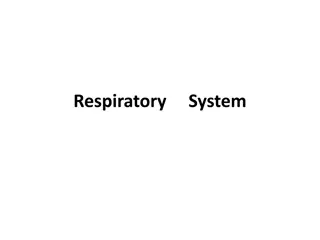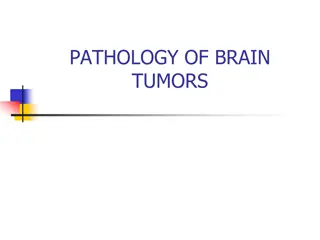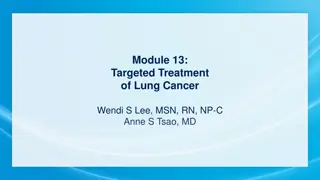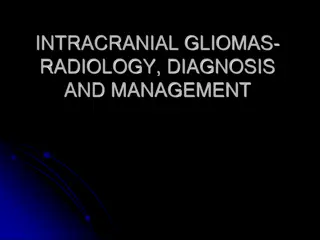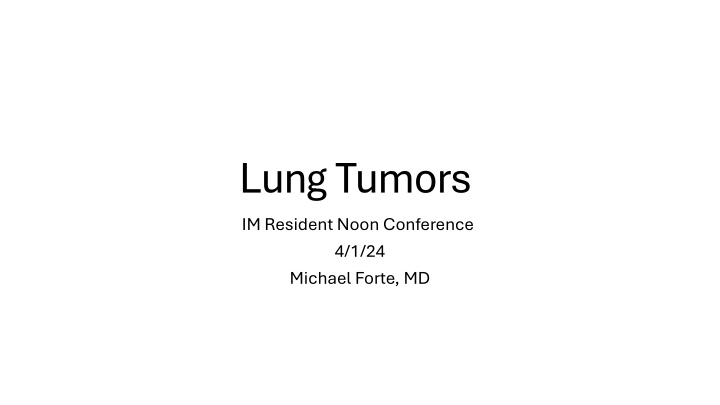
Lung Tumors: Screening, Nodules, and Characteristics
Explore crucial topics on lung tumors, including screening trials, nodule characteristics, morphology, and more. Learn about lung cancer screening guidelines, nodule characteristics, and the significance of calcifications in lung nodules.
Uploaded on | 5 Views
Download Presentation

Please find below an Image/Link to download the presentation.
The content on the website is provided AS IS for your information and personal use only. It may not be sold, licensed, or shared on other websites without obtaining consent from the author. If you encounter any issues during the download, it is possible that the publisher has removed the file from their server.
You are allowed to download the files provided on this website for personal or commercial use, subject to the condition that they are used lawfully. All files are the property of their respective owners.
The content on the website is provided AS IS for your information and personal use only. It may not be sold, licensed, or shared on other websites without obtaining consent from the author.
E N D
Presentation Transcript
Lung Tumors IM Resident Noon Conference 4/1/24 Michael Forte, MD
Outline Lung Cancer screening Lung nodules / Lung Rads Benign Lung Tumors Malignant Neoplasm of the Lung Lung cancer treatment for the internist Paraneoplastic syndromes/malignant pleural effusions
Lung cancer screening National Lung screening trial, NEJM 2011 >53,00 patients at high risk for lung cancer 3 annual CT or single CXR Data collected for over 7 years follow up +screen 24.2% in CT 7% in CXR >96% were false positives Lung cancer incidence higher in CT group. deaths 247 in CT versus 309 in CXR NNTS 320 Death rates reduced by 6.7 percent.
Lung cancer screening Who to screen? 50-80 20 pack years, active smoker, or quit within 15 years No other life limiting conditions Should be able to withstand curative surgery Smoking cessation, shared decision making Potential harms- overdiagnosis, excessive testing, anxiety etc
Lung Nodule Characteristics Volumetric doubling of malignant SPNs occurs in 20 400 days and corresponds to a 26% increase in nodule diameter. SPNs that double in volume in > 400 days are typically benign SPNs that double in volume in < 20 days are often caused by an acute inflammatory process. In general, a solid SPN with stable volume for 2 years can be considered benign. Likelihood of malignancy increases with nodule diameter.
Morphology Smooth edges: Usually benign, but 20 30% of malignant nodules have smooth borders. Irregular, lobulated, and spiculated edges often indicate uneven growth and are usually but not exclusively found in malignant tumors. SPNs surrounded by a halo of ground-glass opacities can indicate adjacent hemorrhage or lepidic spread. Upper lobe more likely malignant Fat on CT- hamartoma
More info CALCIFICATION Benign patterns of calcification on chest CT scan: Central: Bull s eye, Diffuse solid: Granulomatous disease, Laminated: Rings, Popcorn-like: Chondroid matrix, such as hamartoma No pattern of calcification is specific for malignancy. Punctuate and eccentric calcifications are often but not exclusively seen in lung cancer. CAVITATION Secondary to necrosis. Can be seen in malignant and benign SPNs. GROUND-GLASS NODULES Focal nodular areas of increased lung attenuation without obscuring of the lung parenchyma Classified into pure ground-glass and partly solid types. LUNG NEOPLASMS - More solid components are associated with a higher likelihood of malignancy. Have a slower growth rate and low metabolic activity, with a doubling time of > 2 years and low or no activity on PET scan
PET Only useful if nodule solid portion >8 mm SUV > 2.5 increases suspicion for malignancy Sensitivity of 96% and specificity of 79% in differentiating benign from malignant lesions in nodules larger than 8 10 mm SPNs with intermediate pretest probability of malignancy should be evaluated. Tumors with low metabolic rate, ground-glass nodules, and SPNs < 8 10 mm have higher false-negative rates. Infectious and inflammatory conditions yield higher false-positive rates.
Lung Nodule Mimics nipple shadow cutaneous lesion rib fracture or other bone lesion vanishing pseudotumorof congestive heart failure summation of markings artifact
Benign Lung Tumors Hamartomas Hamartomas Most common benign lung neoplasm in adults More common in men Generally discovered incidentally in the sixth or seventh decade Parenchymal or endobronchial (10%) nodules with characteristic popcorn calcification Typically, mature hyaline cartilage with fat, fibromyxoid tissue, and/or smooth muscle cells
Papillomas SQUAMOUS PAPILLOMA Most often associated with cigarette smoking and human papilloma virus. Most occur in central large airways. RECURRENT RESPIRATORY PAPILLOMATOSIS Also known as juvenile laryngotracheal papillomatosis. Associated with human papilloma virus types 11 and 6. Surgical excision and laser ablation are the mainstays of treatment. Lung involvement occurs in 3% of patients and generally has an aggressive course, with no effective medical therapy. Squamous cell carcinoma is the most feared complication and may appear as cavitating nodules or masses
Carcinoid Tumors Pulmonary carcinoid tumors represent about 1 5% of all lung malignancies. There are mainly of two types, typical and atypical: Typical carcinoid: < 2 mitoses per 10 high-power fields and absence of necrosis Atypical carcinoid: > 2 mitoses per 10 high-power fields or presence of necrosis Usually occur in those who have never smoked. About 70% of carcinoids develop in the proximal airways and may be associated with chronic cough, hemoptysis, and bronchial obstruction. Peripheral carcinoids are generally asymptomatic. Fewer than 2% of cases are associated with carcinoid syndrome. Low to moderate activity is seen on PET scan.
Carcinoid Management Treatment of carcinoid tumors is different from that of other types of NSCLC: Typical carcinoid: Limited resection with segmentectomy and regional lymph node dissection Atypical carcinoid: Lobectomy and mediastinal lymph node dissection Metastasis: No known benefit to chemotherapy or radiation therapy. Local treatment of metastases may lead to prolonged remission.
NSCLC-Adenoca. Adenocarcinoma is the most frequently diagnosed histologic type of lung cancer. It is the most common subtype in women and nonsmokers. Most tumors occur in the periphery. Positive immunohistochemical stains include thyroid transcription factor-1, napsin A, and cytokeratin 7.
Adenocarcinoma in situ Previous BAC These very slow-growing neoplasms have a 100% 5-year survival rate if the lesion is < 2 cm at the time of resection. They can present radiographically as ground-glass opacities, with or without a solid component, or as diffuse disease
NSCLC-Squamous Strongly associated with cigarette smoking Occurs predominantly in men. Two thirds of cases occur centrally, with involvement of the main stem, lobar, or segmental bronchi. Compared with other histologic subtypes, it is more commonly associated with cavitation Immunohistochemistry: Usually stains positive for p63, cytokeratin 5/6.
NSCLC-Large Cell Undifferentiated malignant epithelial tumors that lack features of small cell carcinoma and glandular or squamous differentiation. They are characterized by large nuclei, prominent nucleoli, and a moderate amount of cytoplasm.
Small Cell Lung Cancer SCLC is characterized by proliferation of small cells with scant cytoplasm, ill defined borders, salt and pepper chromatin, frequent nuclear molding, and a high mitotic count Staining is usually positive for thyroid transcription factor-1,CD 56, synaptophysin, and chromogranin. SCLC is always considered a systemic disease at diagnosis. Liver, bone, bone marrow, and the central nervous system are the most commonly affected extrapulmonary organs. SCLC shows an excellent response to chemotherapy, but almost always recurs. Median survival for disease confined to the chest is 4 6 months without treatment. For metastatic disease, median survival is 5 9 weeks without treatment.
Staging small cell Although TNM staging can be used in SCLC, many clinicians prefer a simpler two-stage system. Limited stage (25 30% of patients): Disease confined to a single radiation portal or localized to one hemithorax Extensive stage (70 75% of patients): Any disease outside of the hemithorax
Treatment LIMITED DISEASE Response rate of 70 80% to chemotherapy and thoracic radiation therapy, with a complete clinical response rate of 50 60%. Concurrent radiation therapy begins with the first or second cycle of chemotherapy. No benefit has been shown beyond 4 6 cycles of chemotherapy. EXTENSIVE DISEASE Response rate of 60 80% to chemotherapy, with only 20% of patients achieving complete clinical remission. Standard approach is chemotherapy for 4 6 cycles, followed by assessment for progression. Radiation therapy is strictly palliative and can be used for symptomatic control of primary and metastatic lesions. Prophylactic whole brain radiation is recommended for all patients with a good performance status who have attained remission after induction chemotherapy and radiation therapy.
Diagnosis and Staging CT- through adrenals PET- Sensitivity of 74% and specificity of 85% for identifying mediastinal metastases. MRI- mainly for pancoast tumors TTNA- (aka CT biopsy)- Sensitivity and specificity are 90% and 97%, respectively. The main drawback is the risk of pneumothorax, which is 22 45%. Risk is increased with emphysema, smaller lesion size, and greater depth from pleural surface to edge of lesion. Peripheral lesions Peripheral lesions
Diagnosis and Staging - Navigational/Robotic bronchoscopy- becoming most commonly performed procedure. Yields >88% centrally and 71% for peripheral. - EBUS- yields >90% - Indicated any PET avid nodes, nodes >1 cm in any tumor size, lesion >3 cm regardless node or pet avidity
Mediastinoscopy Gold standard Gold standard for staging the mediastinum in patients with known or suspected lung cancer. mainly used to sample nodes of the paratracheal (station 4) and anterior subcarinal (station 7) regions. Mediastinoscopy and video-assisted thoracoscopic surgery are the only methods that can access station 5 nodes. Sensitivity of 78% and specificity of 100% have been reported in nodes that appear to be involved on imaging studies
Paraneoplastic syndrome About 10% of lung cancer patients have one at diagnosis Most frequently small cell.
Paraneoplastic syndrome Hypercalcemia- Elevated calcium in blood is caused by tumor secretion of parathyroid hormone related protein, increased active metabolite of vitamin D (calcitriol), and localized osteolytic hypercalcemia. Tx- IVF, bisphosphonates etc. Squamous cell Can be poor prognostic marker
SIADH Small cell ADH is produced by the tumor in an unregulated manner, leading to water retention by reabsorption in renal tubules. Manifested as euvolemic hypo-osmolar hyponatremia. Tx- FW restriction
Cushing syndrome Caused by ectopic secretion of adrenocorticotropic hormone. Most commonly associated with SCLC and bronchial carcinoid tumors. Diagnostic laboratory tests: High plasma adrenocorticotropic hormone Non-suppressed morning cortisol level after high-dose dexamethasone suppression test Elevated 24-hour urine free cortisol level TX-treat cancer, poor prognosis
Hypertrophic Pulmonary Osteoarthropathy Characterized by digital clubbing , painful symmetrical arthropathy (involving the wrists, elbows, ankles, and knees), and periosteal new bone formation in the distal long bones of the limbs. Associated with adenocarcinoma of the lung.
Metastatic Lung tumors A study was conducted on 228 patients with lung nodules. The study revealed the median age of the group was 61.8 yrs. About 53.5% were male, 46.5 % female. The primary tumor site in these patients was as follows: Colorectal in 25.8%, Head and neck 19.4% Urologic (kidney, ureter, prostate, testes) 14.7% Gastrointestinal non-colorectal cancer 10.9% Breast cancer 10.5% Melanoma 6.5% Gynecologic cancer (ovarian, endometrial, cervical) 6.1% Other primary sites (sarcoma, thyroid, squamous cell) 6.1% Concomitant extra pulmonary nodules were present in 25.9% of cases.
Malignant Mesothelioma Long time after asbestos exposure Nonspecific symptoms No screening test Chest x-ray: Large unilateral pleural effusion obscuring an underlying pleural mass or thickening. Chest CT scan: Better defines the extent of pleural disease. MRI scan: Sometimes delineates soft tissue planes. PET scan: Detects occult metastatic disease in approximately 10% of patients.
MM Biopsy done by VATS usually, pleural fluid cytology low yield. Prognosis poor. Extrapleural pneumonectomy Combination chemo or immunotherapy










